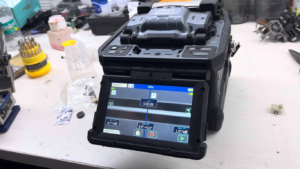In today’s world, fiber optic internet is the key to fast and reliable connections. It powers everything from streaming your favorite shows to video calls with friends and family. But how does it all work? To make sense of this, we need to look at three main parts of the system: the Optical Line Terminal (OLT), fiber optic towers, and the connections that link them. These components work together to deliver high-speed internet to homes, offices, and even rural areas. Let’s break it down.
What is an Optical Line Terminal (OLT)
Think of the OLT as the main control center in a fiber optic network. It’s typically located at the internet service provider’s facility, and it helps manage how data moves through the entire network.
- Sending Signals: The OLT converts the data from your internet into light signals that travel through fiber optic cables. This allows data to travel at super-fast speeds.
- Managing Speed: The OLT also decides how to divide the internet speed fairly between users. This keeps everything running smoothly, especially when lots of people are using the internet at the same time.
- Directing the Data: The OLT sends the data out to other parts of the network, like Optical Network Terminals (ONTs) or Optical Network Units (ONUs), which are devices at people’s homes or businesses. These devices change the light signals back into electrical signals that devices can use, like your phone, laptop, or smart TV.
What Do Fiber Optic Towers Do
Fiber optic towers help extend the reach of the internet over long distances. They play a major role in making sure everyone can stay connected, even in areas where it’s too expensive or difficult to bury cables underground.
- Boosting the Signal: Over long distances, the signal can get weaker. Fiber optic towers act as amplifiers, boosting the signal so it doesn’t lose quality as it travels far.
- Connecting Remote Areas: These towers help connect areas that are far away from the main network, like rural or hard-to-reach regions, by sending the signal over longer distances.
- Handling Lots of Data: Fiber optic towers are designed to carry large amounts of data at once, making sure there’s no slowdown when using high-bandwidth services like streaming videos or video calls.
How OLT, Towers, and Connections Work Together
The OLT, fiber optic towers, and their connections work together to make sure you get fast, reliable internet, whether you live in the city or in a remote area.
- Sending Data from the OLT: The OLT is where the internet data starts. It sends signals out to the fiber optic towers, which carry the signals over long distances.
- Relaying the Signals: These towers act as relay points, helping the signal travel far without losing speed or quality. Without these towers, internet signals could only reach shorter distances, which would make it hard to deliver fast internet to more remote places.
- Getting Data to Your Home: Once the signal reaches the right area, it’s sent to your home or business through the Optical Network Terminal (ONT). This device converts the signal back to something your devices can use.

Why These Connections Matter
The OLT, fiber optic towers, and the connections between them are all important because they ensure that you get the fast, reliable internet you need.
- Fast Internet: Fiber optic internet is known for its speed. Whether you’re streaming movies, playing online games, or just browsing the web, it’s quick and smooth. The OLT, towers, and connections make sure data travels efficiently and without delays.
- Stable Connections: Fiber optic networks are less likely to get interrupted than older types of internet connections. The OLT and towers help keep things stable, even when lots of people are using the internet at the same time.
- Scalability: Fiber optic networks can handle more users and faster speeds as the need for internet grows. As more devices connect to the network, these systems can be upgraded to meet demand, making fiber optic internet future-proof.
Challenges and How They Are Addressed
While fiber optic networks are great, there are still some challenges to consider.
- Cost of Setup: Building fiber optic networks can be expensive. Installing the cables, setting up towers, and putting in OLTs requires a significant investment. However, as demand for fast internet continues to grow, companies and governments are working hard to expand the network.
- Maintenance: Keeping the OLTs, towers, and fiber optic cables in good condition is important for making sure the network continues to run smoothly. Regular maintenance helps prevent problems and keeps the service reliable.
- Environmental Factors: Fiber optic towers can be affected by weather or other physical obstacles like mountains. It’s important to carefully choose tower locations and make sure they can handle different conditions.
Conclusion
To wrap up, the OLT, fiber optic towers, and the connections between them work together to provide high-speed, reliable internet. The OLT acts as the control center, sending data out to towers, which boost the signal and carry it long distances. Without these key components, providing fast internet would be much harder, especially for people in remote areas.
These connections are important because they allow us to enjoy fast, stable, and uninterrupted internet. Whether for streaming, working, or just browsing, fiber optic technology is crucial for staying connected. And as demand for internet grows, these systems can scale to meet future needs. Thanks to the OLT, fiber optic towers, and their connections, the future of internet connectivity looks bright and fast for everyone.
-
Get more information Fiber optic.
